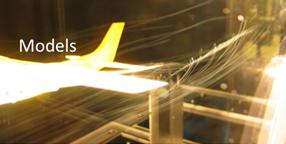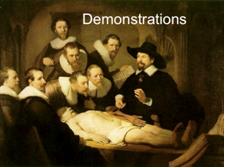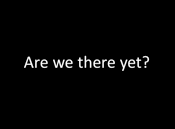In my four decades of teaching, I’ve discovered that sometimes the best thing to do is shut up. Several years ago, I was talking about this with one of my undergrad research assistants. He said, “In that case, you should be doing silent lectures.” The silent lecture genre is now a key part of my undergraduate teaching.
Silent lectures use images to evoke the multiple, intertwined, meanings of basic concepts. The goal is to stimulate the user in the process of making associations. As I teaching tool, I found that it’s a good way to start a discussion.
Here are four such silent lectures – Performance, Models, Demonstrations, and (with Gernot Grabher) Frequently Asked Questions. The ‘lectures’ are available for download. After downloading, click on slide show. They are self-timed. Each runs for about five minutes.
I welcome your feedback and invite others to develop similar devices.
[Click on the images to download the lectures]
Performance
 Musicians, dancers, and actors perform; and audiences applaud. Coaches and sports statisticians measure athletes’ performance. Companies monitor the performance of their employees, stock markets register the performance of firms, and at the semester’s end students are asked to evaluate their professors. Top Ten lists are ubiquitous; online ratings of restaurants, movies, and books abound; and we are frequently asked to rate the reviewers. This slideshow explores the interplay of the real-time skilled achievement of effective performance and the evaluative principles of measurement. From the bedroom to the boardroom, pharmaceutical companies and management consultants promise enhanced performance. We live in an age of performance anxiety.
Musicians, dancers, and actors perform; and audiences applaud. Coaches and sports statisticians measure athletes’ performance. Companies monitor the performance of their employees, stock markets register the performance of firms, and at the semester’s end students are asked to evaluate their professors. Top Ten lists are ubiquitous; online ratings of restaurants, movies, and books abound; and we are frequently asked to rate the reviewers. This slideshow explores the interplay of the real-time skilled achievement of effective performance and the evaluative principles of measurement. From the bedroom to the boardroom, pharmaceutical companies and management consultants promise enhanced performance. We live in an age of performance anxiety.
Models
 We live in an age of modeling. This slideshow explores the interplay of models as representation and experimentation. A model can gesture to some exemplary, even utopian, point. As a figure of imagination, it can be a guide, a model, for action. Models can also represent the current situation or state of knowledge, whether of protein folding, a national economy, or the urban environment. But as we also know from the practice of fashion designers and architects, a model is not simply a means to represent a final product to the client but is also a method for testing and experiment. Examples here include: the extraordinarily detailed scale models of a real estate developer, the hydrological model of the Keynesian economy, and fashion boutiques in Tokyo’s Shibuya district in which the young salewomen model ensembles which they themselves distinctively fashion.
We live in an age of modeling. This slideshow explores the interplay of models as representation and experimentation. A model can gesture to some exemplary, even utopian, point. As a figure of imagination, it can be a guide, a model, for action. Models can also represent the current situation or state of knowledge, whether of protein folding, a national economy, or the urban environment. But as we also know from the practice of fashion designers and architects, a model is not simply a means to represent a final product to the client but is also a method for testing and experiment. Examples here include: the extraordinarily detailed scale models of a real estate developer, the hydrological model of the Keynesian economy, and fashion boutiques in Tokyo’s Shibuya district in which the young salewomen model ensembles which they themselves distinctively fashion.
Demonstrations
 What is an effective demonstration? Protestors demonstrate. Engineers demonstrate their inventions. Rock bands, technologists, and website builders make demos – working models at various levels of completion that point to capacities for further development just as a protest demonstrates capacities for further escalation. An engagement ring signals commitment and demonstrates future earnings potential. This slideshow explores the interplay of political, commercial, and technological demonstrations. A Steve Jobs’ demonstration of a new Apple product is orchestrated to resonate with Mac or iPod users as a quasi-social movement. And before it was a film, Al Gore’s slideware demonstrated the threat of environmental catastrophe. Demonstrations are important for a vibrant democracy. Because political and technical issues are increasingly intertwined, effective demonstrations are likely to mobilize charts, graphs, models, and simulations no less than the mobilization of protestors in the street.
What is an effective demonstration? Protestors demonstrate. Engineers demonstrate their inventions. Rock bands, technologists, and website builders make demos – working models at various levels of completion that point to capacities for further development just as a protest demonstrates capacities for further escalation. An engagement ring signals commitment and demonstrates future earnings potential. This slideshow explores the interplay of political, commercial, and technological demonstrations. A Steve Jobs’ demonstration of a new Apple product is orchestrated to resonate with Mac or iPod users as a quasi-social movement. And before it was a film, Al Gore’s slideware demonstrated the threat of environmental catastrophe. Demonstrations are important for a vibrant democracy. Because political and technical issues are increasingly intertwined, effective demonstrations are likely to mobilize charts, graphs, models, and simulations no less than the mobilization of protestors in the street.
Frequently Asked Questions
 In this silent lecture, Gernot Grabher and I explore the genre of frequently asked questions. Keywords: innocence, anticipation, confusion, frustration, resignation, desperation, provocation, hostility.
In this silent lecture, Gernot Grabher and I explore the genre of frequently asked questions. Keywords: innocence, anticipation, confusion, frustration, resignation, desperation, provocation, hostility.